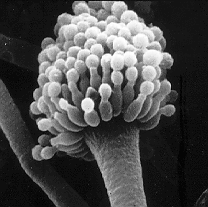Eurotiales
Eurotiales is an order of fungi within the class Eurotiomycetes, which belongs to the division Ascomycota. This order encompasses a diverse group of fungi, many of which are of significant importance in environmental science, medicine, and industry. The Eurotiales are characterized by their unique reproductive structures, particularly their ascocarps or fruiting bodies, which are often closed and flask-shaped, known as cleistothecia. These fungi are predominantly saprophytic, decomposing dead organic material, but the order also includes several notable pathogens and mutualists.
Characteristics[edit | edit source]
Eurotiales fungi are primarily known for their distinctive morphology and reproductive mechanisms. They produce cleistothecia, which are spherical to flask-shaped fruiting bodies that enclose the asci, where the spores are formed. The asci are typically spherical or sac-like and release spores in a variety of ways, often involving the disintegration of the ascus wall. Many species within this order are anamorphic, meaning they can reproduce asexually by producing conidia, which are asexual spores that are not enclosed in a sac.
Ecology[edit | edit source]
The ecological roles of Eurotiales are diverse, with members found in a wide range of habitats, including soil, plant debris, and in association with various plants and animals. Some species are important decomposers in their ecosystems, breaking down complex organic compounds. Others form symbiotic relationships with plants, such as mycorrhizae, which enhance nutrient uptake for the host plant. Additionally, certain species are known to be pathogenic, causing diseases in plants, animals, and humans.
Economic and Medical Importance[edit | edit source]
Several members of the Eurotiales have significant economic and medical importance. For example, the genus Aspergillus includes species that are used industrially for the production of enzymes, organic acids, and antibiotics, as well as in fermentation processes for food and beverage production. However, some Aspergillus species can also be harmful, producing mycotoxins that contaminate food and feed, or causing aspergillosis, a serious infection in humans and animals.
Another notable genus is Penicillium, which is renowned for its role in the discovery of penicillin, the first widely used antibiotic. Penicillium species are also used in the production of cheese and other fermented products. However, like Aspergillus, some Penicillium species can produce mycotoxins, posing risks to health and food safety.
Classification[edit | edit source]
The classification of Eurotiales has evolved with advances in molecular and genetic research. Traditionally, classification was based on morphological characteristics, but modern phylogenetic studies have led to a more nuanced understanding of the relationships within this order. The Eurotiales includes several families, with the most well-known being the Aspergillaceae and Trichocomaceae.
Research and Future Directions[edit | edit source]
Research on Eurotiales continues to expand our understanding of fungal biology, ecology, and evolution. Studies on the genetic and molecular basis of pathogenicity, symbiosis, and secondary metabolite production are of particular interest. Furthermore, the potential for biotechnological applications of Eurotiales fungi, including in bioremediation, pharmaceuticals, and sustainable biofuels, is an area of active investigation.
Search WikiMD
Ad.Tired of being Overweight? Try W8MD's physician weight loss program.
Semaglutide (Ozempic / Wegovy and Tirzepatide (Mounjaro / Zepbound) available.
Advertise on WikiMD
|
WikiMD's Wellness Encyclopedia |
| Let Food Be Thy Medicine Medicine Thy Food - Hippocrates |
Translate this page: - East Asian
中文,
日本,
한국어,
South Asian
हिन्दी,
தமிழ்,
తెలుగు,
Urdu,
ಕನ್ನಡ,
Southeast Asian
Indonesian,
Vietnamese,
Thai,
မြန်မာဘာသာ,
বাংলা
European
español,
Deutsch,
français,
Greek,
português do Brasil,
polski,
română,
русский,
Nederlands,
norsk,
svenska,
suomi,
Italian
Middle Eastern & African
عربى,
Turkish,
Persian,
Hebrew,
Afrikaans,
isiZulu,
Kiswahili,
Other
Bulgarian,
Hungarian,
Czech,
Swedish,
മലയാളം,
मराठी,
ਪੰਜਾਬੀ,
ગુજરાતી,
Portuguese,
Ukrainian
Medical Disclaimer: WikiMD is not a substitute for professional medical advice. The information on WikiMD is provided as an information resource only, may be incorrect, outdated or misleading, and is not to be used or relied on for any diagnostic or treatment purposes. Please consult your health care provider before making any healthcare decisions or for guidance about a specific medical condition. WikiMD expressly disclaims responsibility, and shall have no liability, for any damages, loss, injury, or liability whatsoever suffered as a result of your reliance on the information contained in this site. By visiting this site you agree to the foregoing terms and conditions, which may from time to time be changed or supplemented by WikiMD. If you do not agree to the foregoing terms and conditions, you should not enter or use this site. See full disclaimer.
Credits:Most images are courtesy of Wikimedia commons, and templates, categories Wikipedia, licensed under CC BY SA or similar.
Contributors: Prab R. Tumpati, MD

